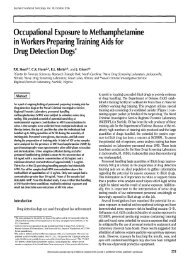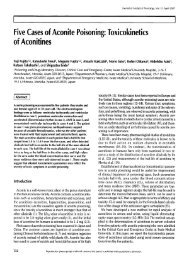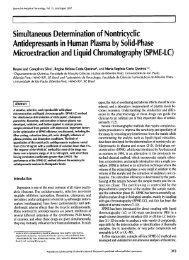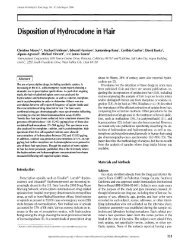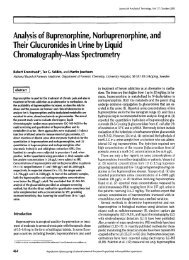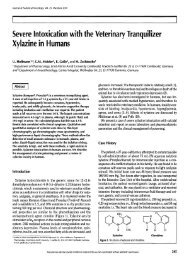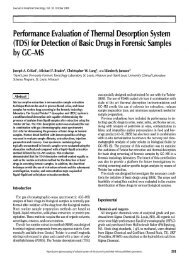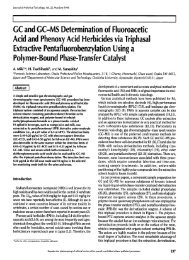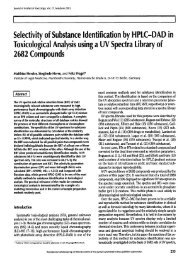Urinary Excretion Rates of Ketamine and Norketamine Following ...
Urinary Excretion Rates of Ketamine and Norketamine Following ...
Urinary Excretion Rates of Ketamine and Norketamine Following ...
Create successful ePaper yourself
Turn your PDF publications into a flip-book with our unique Google optimized e-Paper software.
Journal <strong>of</strong> Analytical Toxicology, Vol. 28, July/August 2005<br />
dreamy thinking, disturbances <strong>of</strong> speech, hearing <strong>and</strong> seeing,<br />
lack <strong>of</strong> muscle coordination, disorientation, anxiety, disinhibi-<br />
tions, euphoria, seeing the world differently, <strong>and</strong> irrational be-<br />
havior. Higher doses cause great difficulty in moving, respiratory<br />
disturbances, seizures, <strong>and</strong> nausea. Extreme doses produce com-<br />
plete disassociation from reality <strong>and</strong> loss <strong>of</strong> consciousness, hal-<br />
lucinations, out-<strong>of</strong>-body experiences, <strong>and</strong> so-called "near-death<br />
experiences". Frequent intake <strong>of</strong> ketamine can lead to psycho-<br />
logical <strong>and</strong> physical dependency <strong>and</strong> tolerance (12-14).<br />
Deaths by overdose in the absence <strong>of</strong> other drugs are excep-<br />
tionally rare (5,15). Overdose in the case <strong>of</strong> ketamine is a very<br />
relative term, because doses used by drug-addicts are typically<br />
lower than necessary for anesthesia. The highest therapeutic<br />
dose is 13 mg/kg, while doses taken to induce psychedelic effects<br />
rarely exceed 2 mg/kg. Accidental deaths such as falling from a<br />
great height, death by hypothermia, car accident, or drowning<br />
in a bathtub are the most common ketamine-related deaths<br />
(7).<br />
<strong>Ketamine</strong> is rapidly metabolized to an active metabolite, nor-<br />
ketamine, <strong>and</strong> an inactive metabolite, 6-hydroxynorketamine.<br />
The major pathway is N-demethylation to norketamine by the<br />
microsomal cytochrome P450 system (8). <strong>Norketamine</strong> is also<br />
hydroxylated to 6-hydroxynorketamine, conjugated, <strong>and</strong> ex-<br />
creted in the urine. Hydroxylation <strong>and</strong> conjugation <strong>of</strong> glu-<br />
curonic acid with norketamine <strong>and</strong> its hydroxylated metabolites<br />
generate water-soluble compounds to facilitate urinary excretion<br />
(9). <strong>Norketamine</strong> also undergoes dehydrogenation to dehy-<br />
dronorketamine. It had been suggested that dehydronorke-<br />
Table I <strong>Urinary</strong> <strong>Excretion</strong> <strong>of</strong> <strong>Ketamine</strong> <strong>and</strong> <strong>Norketamine</strong> <strong>Following</strong> <strong>Ketamine</strong> Administration to Children*<br />
Concentrations (ng/mL) Measured by Concentrations (ng/mL) Measured by<br />
LC-MS-APCI GC-MS-NCI LC-MS-APCI GC-MS-NCI<br />
Day <strong>Ketamine</strong> <strong>Norketamine</strong> <strong>Ketamine</strong> <strong>Norketamine</strong> Day <strong>Ketamine</strong> <strong>Norketamine</strong> <strong>Ketamine</strong> <strong>Norketamine</strong><br />
Case 1<br />
0-1 urine samples not collected<br />
2 - 50 - 57<br />
3 - 7 - 3<br />
4 - 5 - 2<br />
5 - 5 - 0.4<br />
6 - 4 - 0.4<br />
7 - - 0.2<br />
8 - - 0.06<br />
9 - - 0.1<br />
10 - - 0.2<br />
11 - - 0.2<br />
12 - - - 0.1<br />
13 - - 0.08<br />
14 - - - 0.05<br />
15-16 urine samples tested negative<br />
Case 2A<br />
0 urine sample not collected<br />
1 41 264 41 227<br />
2 4 18 - 11<br />
3 - 3 - 2<br />
4 - - - 0.4<br />
5 - - - 0.6<br />
Case 2B<br />
0 799 409 695 534<br />
1 52 387 58 325<br />
3 3 2 - 2<br />
5 - - - 0.1<br />
7 2 - - -<br />
9 6 - - -<br />
11 4 - - -<br />
Case 2C<br />
0 urine sample not collected<br />
1 813 548 1181 743<br />
2 195 417 296<br />
3 17 85 -<br />
4 7 17 -<br />
5 3 6 -<br />
Case 3<br />
0 urine sample not collected<br />
1 161 527<br />
2 110 34<br />
3 - 5<br />
4 - 3<br />
5 - 2<br />
6<br />
7<br />
Case 4<br />
0 502 1276<br />
1 12 206<br />
2 - 5<br />
3 - 2<br />
5 - 3<br />
6<br />
7-15 urine samples tested negative<br />
Case 5<br />
179<br />
156<br />
586<br />
496<br />
0 urine sample not collected<br />
1 30 166 29 147<br />
Case 6<br />
82<br />
13<br />
3<br />
430<br />
52<br />
2<br />
2<br />
1182<br />
0 1204 1559 1410 1442<br />
0.7<br />
0.1<br />
184<br />
1<br />
1 467 535 642 553<br />
2 55 52 71 72<br />
3 - 6 - 3<br />
4 - 4 - 1<br />
5 - 3 - 0.6<br />
6 - - 0.1<br />
* Day 0: the day <strong>of</strong> ketamine administration; Day 1 : the first day after ketamine administration; Cases 2A, 2B, <strong>and</strong> 2C represent urine samples collected from one patient to<br />
whom ketamine was administered three times during two-year period.<br />
0.06<br />
0.6<br />
0.1<br />
0.07<br />
377



